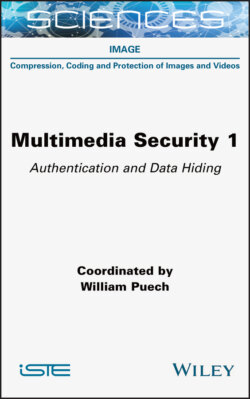Читать книгу Multimedia Security, Volume 1 - William Puech - Страница 44
1.5.2.2. DCT coefficients
ОглавлениеThese are methods based on the impact of compression on the DCT coefficients. After quantization, the compression makes the size of the image file smaller by setting many of the DCT values to zero. As illustrated in Figure 1.5, the quantization leads to setting a lot of the high-frequency coefficients to zero. The values of the quantization matrix are generally larger in high frequencies. The stronger the compression, the more values are set to zero.
Figure 1.10. Derivative filter and vote map applied to the same image without compression in a) and after JPEG compression of quality 80 in b)
COMMENT ON FIGURE 1.10.– The compressed image features a grid structure. The saturated zone on the right of the image hides any traces of compression. In the vote map, each pixel is associated with the grid for which it voted, in other words, the grid with the most zeros. For the compressed image, one color is dominant: it corresponds to the position (0, 0).
Based on the example of CAGI (Iakovidou et al. 2018), the ZERO method determines the origin of the grid by testing the 64 possibilities and selecting the one on which the DCT coefficients of the blocks has the most zeros (Nikoukhah et al. 2019). In other words, given an image, all of its pixels vote for the grid they think they belong to. In the event of a tie, the vote is not taken into account.
Figures 1.10(e) and 1.10(f) present the vote map: each pixel’s color represents which of the 64 possible grids the pixel notes. Navy blue corresponds to the original grid (0, 0), and red to a non-valid vote, in the event of a tie. At the top right of the image, the saturated zone is not used to detect JPEG traces since it does not contain any information.
The derivative filter presented in Figures 1.10(c) and 1.10(d) makes it possible to highlight the compression artifacts, and the vote map presented in Figures 1.10(e) and 1.10(f) is a colormap where each color is associated with a grid origin. In both cases, there is a clear difference between the image that has not undergone compression and the one which has undergone compression. In fact, these filters, which are part of the tools used by journalists and police experts today, lack a validation step. Indeed, as they are presented, users need to interpret them. It is important to understand why a filter detects one area rather than another. The goal would be to get a binary result.
In the case of an uncompressed image, no “vote” stands out significantly compared to the others. In the case of the compressed image in Figure 1.10(f), navy blue is dominant: it corresponds to position (0, 0).
Whether it is the cross-difference or the pixel vote map, some areas remain difficult to interpret, therefore justifying the need for a statistical validation. For example, the saturated parts have no visible JPEG grid and therefore cannot be used to reach a decision.
